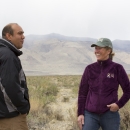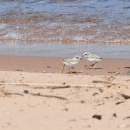About Us
The New Jersey Field Office is located in Galloway, New Jersey, a short distance outside of Atlantic City. We are the local Ecological Services field station, serving all of New Jersey in four program areas: endangered species, conservation planning assistance, environmental contaminants, and private lands restoration.
What We Do
The New Jersey Field Office works with experts, conservation groups, landowners, and many others to protect and recover threatened and endangered species. We coordinate with federal and state agencies, local governments, the business community, and private citizens to make sure that wildlife resources are considered during project planning, such as for transportation, energy, coastal management, and development. New Jersey Field Office biologists serve on oil spill response teams, investigate the effects of environmental contamination, and work to restore polluted habitats. And we work with private landowners to restore fish and wildlife habitats.
Here are some of our focal programs in New Jersey:
Conservation Planning Assistance
Endangered Species
Environmental Response and Restoration
Partners for Fish and Wildlife
Our Organization
Our Species
| Federally Listed or Proposed Species | Other Species |
|---|---|
| bog turtle eastern black rail piping plover rufa red knot roseate tern Indiana bat northern long-eared bat tricolored bat** dwarf wedgemussel green floater**@ northeastern beach tiger beetle monarch butterfly**@ small whorled pogonia swamp pink Knieskern's beaked-rush American chaffseed sensitive joint-vetch seabeach amaranth | blueback herring @ alewife @ spotted turtle*@ wood turtle*@ American black duck northern bobwhite black-crowned night heron bald eagle*** American oystercatcher @ whimbrel @ ruddy turnstone @ eastern whip-poor-will @ wood thrush @ cerulean warbler @ golden-winged warbler*@ prairie warbler saltmarsh sparrow*@ savannah sparrow little brown bat* hoary bat* brook floater @ tidewater mucket @ yellow lampmussel @ Septima's clubtail dragonfly*@ Appalachian grizzled skipper*@ eastern arogos skipper @ frosted elfin*@ regal fritillary* American bumble bee*@ variable cuckoo bumble bee* |
@ Priority at-risk species
* Being evaluated for possible listing under the ESA (National Listing Workplan)
** Proposed for listing under the ESA
*** Protected by the Bald and Golden Eagle Protection Act
Our Library
Visit our library for species survey protocols, surveyor lists, guidance documents, and great information about New Jersey's varied ecosystems and habitats.
Get Involved
There are many opportunities to enjoy and help wildlife in New Jersey!



























